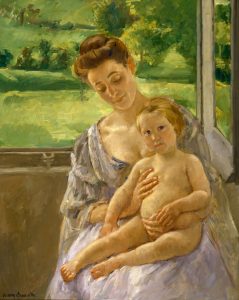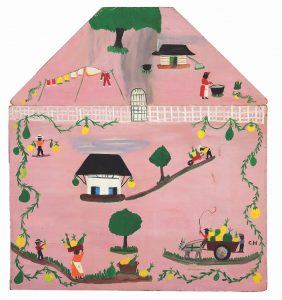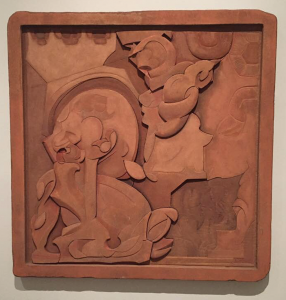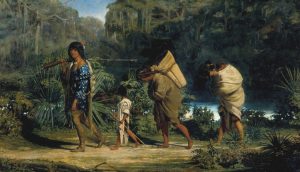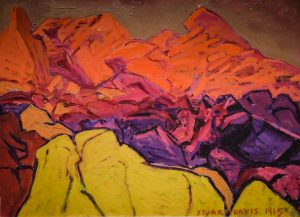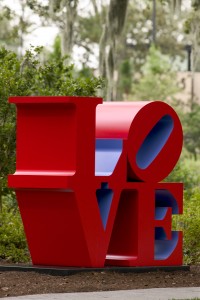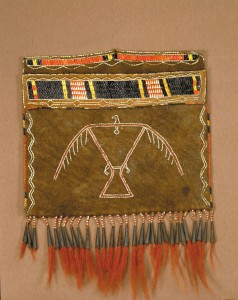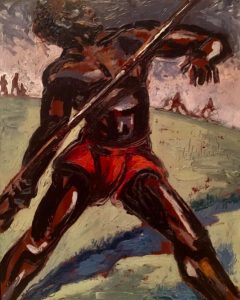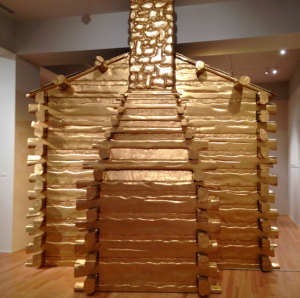NOMA and the Besthoff Sculpture Garden will be open on Thursday, July 4, with special Independence Day holiday hours from noon to 5 pm.
American art is as diverse as the nation itself. NOMA’s collection spans the country’s historical evolution and diverse ethnicities, from pre-Columbian Native American tribal art to cutting-edge contemporary works that express the freedom of unbound creativity. Listed here are ten must-sees spread throughout our galleries and the Besthoff Sculpture Garden.
Gilbert Stuart, George Washington (c. 1800)
This iconic portrait of George Washington by Gilbert Stuart (1755–1828) is one of the most mass-produced and recognizable paintings of the lauded general and America’s first president—even serving as the basis for the image on the one dollar bill. The Washington portrait is on view in the decorative arts galleries at NOMA where it is paired with a selection of colonial-era American furniture.
Mary Cassatt, Mother and Child in the Conservatory (1906)
Mary Cassatt was an American painter who lived and worked for most of her career in France, where she developed a close relationship with Edgar Degas and other Impressionists. Though daringly independent in her years as a young artist and never married, in her early 30s Cassatt was forced to care for her ailing sister and lived with her parents. She turned her attention to domestic scenes and became best known for her depictions of the private sphere of women, with special emphasis on the intimate bond between mothers and children. Unlike most portraiture of the time, most of Cassatt’s paintings were not commissions. She often used models and, on occasion, friends or working women to portray the mothers, and the children were not the real child of the “mother” in the painting.
Clementine Hunter, Harvesting Gourds near the African House and Wash Day Near Ghana House, Melrose Plantation (1959)
In the spring of 2018, NOMA acquired a monumental mural painting by Clementine Hunter (1887–1988), one of Louisiana’s most beloved and accomplished artists. An extremely rare example of one of the large-scale, site-specific murals Hunter created for the interiors of Melrose Plantation in the Cane River region near Natchitoches, where she spent much of her life working as a field hand before pursuing her talent as a painter after age 50, the painting features vignettes of workday activity. Hunter died at age 101 in 1988 and was the first African American woman to have a solo exhibition at the Delgado Museum of Art (later renamed the New Orleans Museum of Art).
Manierre Dawson, Classic Relief (1938)
Manierre Dawson (1887–1969) was one of the first abstract artists in America and in contention for creating the first American abstract painting. Originally a civil engineer, Dawson incorporated many geometric shapes and designs into his artwork. Ending his life in obscurity and struggling financially, Dawson made his art from what was available: cement, caps of lumber, and in this case a piece of plywood carved and covered in oil paint.
Alfred Boisseau, Louisiana Indians Walking Along a Bayou (1847)
Born in Paris, American/Canadian artist Alfred Boisseau (1823–1900) spent two years in New Orleans during the 1840s while his brother served as secretary to the French consul. While in Louisiana he took particular interest in the state’s Native American population. The 1830s and 1840s witnessed the passage of the Indian Removal Act and devastating human rights abuses against Native Americans. The rapid disappearance of Native American culture was the subject of considerable international concern.
Stuart Davis, Rocks, Gloucester (1915)
In 1915, artist Stuart Davis (1892–1964) summered in Gloucester, Massachusetts, where he became drawn to the rugged New England coast and the weatherbeaten town of fishermen. He returned for years thereafter, and Davis’s Gloucester work established him as an integral part of the development of American Modernism. He had already been influenced by his New York teacher Robert Henri who was one of the first American artists to concentrate on painting everyday life and its tumult.
Robert Indiana, LOVE Red Blue (1966–1997)
One of many copies of the famous LOVE sculpture by Robert Indiana (1928–2018) is found in the Sydney and Walda Besthoff Sculpture Garden. Originally created as a print for the Museum of Modern Art’s Christmas card in 1966, it later became three-dimensional. The artist wrote in 1969, “The LOVE sculpture is the culmination of ten years of work based on the original premise that the word is an appropriated and usable element of art, just as Picasso and the Cubists made use of it at the beginning of the century, which evolved inevitably, in both my ‘LOVE’ paintings and sculpture, into the concept that the word is also a fit and viable subject for art.”
Anishinaabe (Chippewa, Ojibwa) Peoples, Shoulder Pouch (c. 1780)
This decorated shoulder pouch served a practical purpose among the Anishinaabe Peoples of both Canada and the United States in a territory that encompassed the Great Lakes. The pouch is made of materials found in the fauna of the northern woodlands, including black-dyed buck skin, natural and dyed porcupine quills, dyed deer hair, and metal cones, which would have been introduced by way of European colonial trade.
Claude Clark, The Javelin (1942)
Playing a pivotal role in African American art as both an artist and educator, Claude Clark (1915–2001) developed the first curriculum for a college-level African American studies course and organized early exhibitions of African American contemporary art. The Javelin, as well as many of Clark’s works, emphasizes strength, purpose, and a sense of pride in African American heritage.
Will Ryman, America (2013)
This large-scale, gold-painted log cabin assembled on the second floor of the museum evokes the humble pioneer boyhood home of Abraham Lincoln as an iconic emblem of American socio-economic conflict during the Civil War and its eventual transformation. . The interior features a kaleidoscopic assemblage of items representing the industries and economies that built the United States. Built as a chronicle of capitalism in America, this structure features everything from cigarettes to coal and cotton to candy—all painted a luminous shade of gold.
NOMA intern Philip Carbo contributed to this list.

